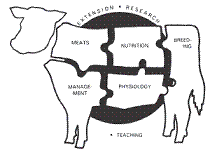Animal Science, Department of

Nebraska Beef Cattle Reports
Date of this Version
January 1996
Abstract
Muscle growth is the primary objective of meat animal livestock producers and represents a major source of amino acids and energy within the animal. Endogenous and exogenous factors that impinge on muscle cell development may influence the animal throughout its life cycle. In the adult animal, treatment with hormones, such as anabolic steroids or insulin, can affect muscle metabolism. Attempting to determine a compound's effects on muscle cell development and metabolism can be obscured in animal trials, since other organs and tissues are altering the environment.
Muscle cell culture provides a research tool to determine the direct effects of a specific compound. There are several advantages to cell culture use. First, the cells can be grown as a "pure" culture. Ideally, the cells are of the same type. Secondly, the culture environment can be controlled. The environment includes the atmosphere, temperature, pH, and the available nutrients. Finally, the sample processing can be simple and rapid. Cell culture results permit researchers to look at complex problems in a simplified model; however, these results need to take the complex nature of the animal into account.
There have been many reports using muscle cell culture; however, most reports involve established cell lines from either mouse or rat sources. The definition of a cell line is a cell culture that has been passaged, or transferred to a new culture dish, many times. Many established cell lines have been routinely cultured for years, and the cell characteristics may have changed from the original tissue source with time. Few researchers have used bovine muscle cells in their studies. It is difficult for most researchers to obtain a reliable source of fetal tissue. Nebraska has a number of beef processing facilities available. which would provide a convenient fetal tissue source. The objective of this study is to develop a muscle cell culture system derived from bovine fetal muscle tissue. This cell culture system would permit the study of potential economically important compounds and their effects on bovine muscle.


Comments
Published in 1996 Nebraska Beef Cattle Report; published by Agricultural Research Division, Institute of Agriculture and Natural Resources, University of Nebraska-Lincoln.